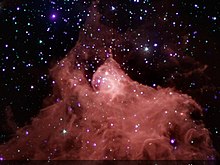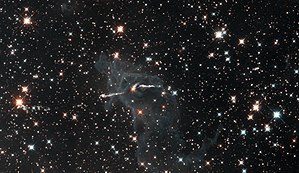Infrared dark cloud



An infrared dark cloud (IRDC) is a cold, dense region of a giant molecular cloud. They can be seen in silhouette against the bright diffuse mid-infrared emission from the galactic plane.[1][2]
Discovery
[edit]Infrared dark clouds have only been recently discovered in 1996 using the ISO[3] and therefore are in need of further research.[4] The Spitzer Space telescope, created by NASA to detect infrared radiation,[5] assisted in the location and identification of infrared dark clouds. The highly sensitive telescope was used to analyze the Milky Way and create numerous astronomical surveys at wavelengths that allowed for the detailed analysis of IRDCs. Through the use of convolutional neural networks,[6] an IRDC catalog consisting of 18,845 items was created by two astronomers named Jyothish Pari and Joe Hora, who created a computer algorithm which could efficiently scan the images created by the Spitzer telescope’s IRAC camera to find infrared dark clouds.[7]
Importance
[edit]Astronomers believe that they represent the earliest stage in the formation of high-mass stars [8] and are therefore of great importance for understanding the star formation process as a whole.[9]
Statistics and Mass
[edit]This section needs expansion. You can help by adding to it. (December 2010) |
See also
[edit]References
[edit]- ^ "Infrared Dark Clouds".
- ^ "Archived copy" (PDF). Archived from the original (PDF) on 2017-08-09. Retrieved 2010-12-04.
{{cite web}}: CS1 maint: archived copy as title (link) - ^ "Archived copy". Archived from the original on 2011-01-01. Retrieved 2010-12-04.
{{cite web}}: CS1 maint: archived copy as title (link) - ^ Frieswijk, W. W. F.; Shipman, R. F. (2010). "Searching for dark clouds in the outer galactic plane. I. A statistical approach for identifying extended red(dened) regions in 2MASS". Astronomy and Astrophysics. 515: 51. arXiv:1005.4955. Bibcode:2010A&A...515A..51F. doi:10.1051/0004-6361/200913000. S2CID 119207620.
- ^ "Spitzer Space Telescope". science.nasa.gov. Retrieved 2024-04-13.
- ^ Pari, Jyothish; Hora, Joseph L. (2020-05-01). "A Semi-Automated Computational Approach for Infrared Dark Cloud Localization: A Catalog of Infrared Dark Clouds". Publications of the Astronomical Society of the Pacific. 132 (1011): 054301. arXiv:2003.01122. doi:10.1088/1538-3873/ab7b39. ISSN 0004-6280.
- ^ "A New Catalog of Infrared Dark Clouds". Center for Astrophysics Harvard and Smithsonian. Retrieved 13 April 2024.
- ^ Rathborne, J. M.; Jackson, J. M.; Chambers, E. T.; Stojimirovic, I.; Simon, R.; Shipman, R.; Frieswijk, W. (2010). "The Early Stages of Star Formation in Infrared Dark Clouds: Characterizing the Core Dust Properties". The Astrophysical Journal. 715 (1): 310–322. arXiv:1003.3193. Bibcode:2010ApJ...715..310R. doi:10.1088/0004-637X/715/1/310. S2CID 119276880.
- ^ Rathborne, J. M.; Jackson, J. M.; Chambers, E. T.; Stojimirovic, I.; Simon, R.; Shipman, R.; Frieswijk, W. (2010). "The Early Stages of Star Formation in Infrared Dark Clouds: Characterizing the Core Dust Properties". The Astrophysical Journal. 715 (1): 310–322. arXiv:1003.3193. Bibcode:2010ApJ...715..310R. doi:10.1088/0004-637X/715/1/310. S2CID 119276880.
- ^ "Archived copy" (PDF). Archived from the original (PDF) on 2017-08-09. Retrieved 2010-12-04.
{{cite web}}: CS1 maint: archived copy as title (link)
